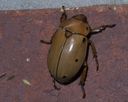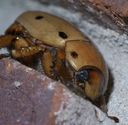Grapevine Beetle
Pelidnota punctata
Classification
- Phylum: Arthropoda
- Subphylum: Hexapoda
- Class: Insecta
- Order: Coleoptera
- Suborder: Polyphaga
- Superfamily: Scarabaeoidea
- Family: Scarabaeidae
- Subfamily: Rutelinae
- Tribe: Rutelini
- Genus: Pelidnota
- Species: punctata
Pronunciation
How to pronounce Pelidnota punctata: //pɛˈlɪdnəʊtə pʌŋkˈtɑːtə//
These audio files are automatically generated. While they are not always 100% accurate, they are a good starting point.
Images






Summary
Pelidnota punctata, also known as the grapevine beetle, is a large scarab beetle characterized by its distinct color patterns and feeding habits on grapevines. It demonstrates regional variability in physical characteristics and is primarily found in eastern North America during the summer months.
Physical Characteristics
Large, golden-yellow scarab with peripheral spots on pronotum and elytra, approximately 17-27 mm in length. Adults have a pattern of off-yellow or auburn red with four black spots on each side. Fine black lines border the edges of the elytra. Variants exist with southern forms typically having light brown legs and northern forms having darker legs and more spots.
Identification Tips
Adults are approximately 2.5 cm (1 inch) long, occasionally reaching 3 cm (1.2 in). Look for the distinct pattern of black spots and coloring on the elytra. Their regional form and leg color can also help in identification.
Habitat
Deciduous forests, thickets, and adjacent areas, commonly seen in vineyards and gardens throughout eastern North America.
Distribution
Commonly found in the northern and central United States and eastern Canada, from Ontario and Maine to Florida, and west to Texas and South Dakota.
Diet
Adults primarily feed on grape (Vitis) foliage and fruit, both wild and cultivated. They are not a major pest.
Life Cycle
Life cycle takes about two years. Adults emerge in May-September and are active primarily in July. Larvae feed on decaying roots and stumps, and pupate in the adjacent soil.
Reproduction
Eggs are laid on stumps, rotting logs, or in the soil near host plants. Larvae hatch from eggs and develop by feeding on rotted wood.
Collecting Methods
- Light traps
- Sweep nets
- Hand collection during active flight
Preservation Methods
- Pin specimens
- Store in alcohol
- Drying specimens
Evolution
Originally described as Scarabaeus punctatus by Linnaeus in 1758. The taxonomy has seen confusion, with authorities previously splitting the species into multiple taxa.
Misconceptions
Despite the name 'grapevine beetle', they are not considered serious pests of grapevines.
Tags
- beetle
- Pelidnota
- grapevine beetle
- Coleoptera
- Scarabaeidae